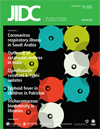Is nalidixic acid screening still valid for the detection of reduced susceptibility of fluoroquinolone with SalmonellaTyphi?
DOI:
https://doi.org/10.3855/jidc.1910Keywords:
enteric fever, antimicrobial resistance, nalidixic acid susceptible, fluoroquinolone resistantAbstract
Introduction: Considering the limitations of screening with nalidixic acid to detect reduced susceptibility to fluoroquinolones of Salmonella enterica serovar Typhi (S.Typhi) strains, we evaluated the use of a 30 µg nalidixic acid disc screening method in Pakistan.
Methodology: Non duplicate nalidixic acid susceptible S. Typhi isolates (246) from 2003-2008 were retrieved from the Salmonella strain bank. Minimum inhibitory concentrations of ciprofloxacin for all strains were determined by agar dilution and further rechecked by ciprofloxacin E-tests.E. coli ATCC 25922 was used as the control strain. The MIC data for ciprofloxacin were compared with nalidixic acid disk (30µg) zone diameters.
Results: Repeat testing of all S. Typhi isolates with a nalidixic acid (30µg) disk showed 100% susceptibility with an average zone diameter of 26 mm. Agar dilution testing revealed reduced susceptibility to ciprofloxacin, with MICs of 0.125 µg /ml for three (1.2%) isolates only. Zone sizes of strains with higher MICs were significantly lower than the strains with lower MICs (20 versus 26 mm) (p value < 0.001).
Conclusion: Estimation of fluoroquinolone MICs on every nalidixic acid susceptible S. Typhi strain is not cost effective in our setting; the proportion of strains with high fluoroquinolone MICs was found to be very low. We recommend periodic fluoroquinolone MIC determination to include all isolates with a nalidixic acid borderline zone (size 20-22 mm).
Downloads
Published
How to Cite
Issue
Section
License
Authors who publish with this journal agree to the following terms:
- Authors retain copyright and grant the journal right of first publication with the work simultaneously licensed under a Creative Commons Attribution License that allows others to share the work with an acknowledgement of the work's authorship and initial publication in this journal.
- Authors are able to enter into separate, additional contractual arrangements for the non-exclusive distribution of the journal's published version of the work (e.g., post it to an institutional repository or publish it in a book), with an acknowledgement of its initial publication in this journal.
- Authors are permitted and encouraged to post their work online (e.g., in institutional repositories or on their website) prior to and during the submission process, as it can lead to productive exchanges, as well as earlier and greater citation of published work (See The Effect of Open Access).








